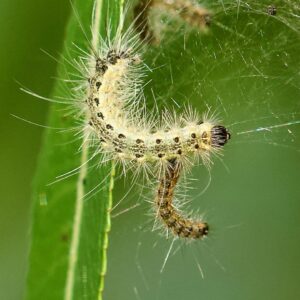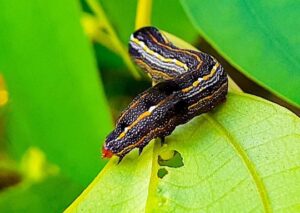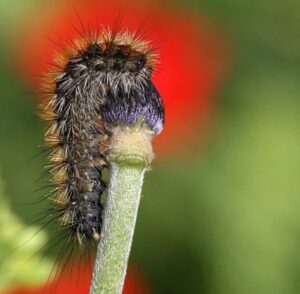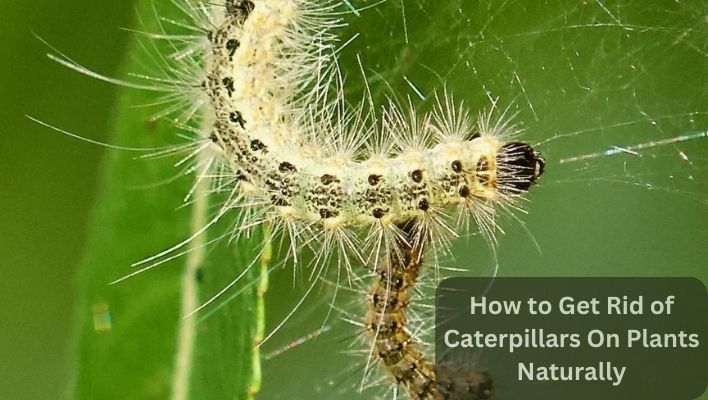Caterpillars are the larval stage of butterflies and moths. While they may be cute and harmless in small numbers, an infestation of these critters can cause severe damage to your plants.
These voracious pests can strip your plants of their leaves, leaving them weak and vulnerable to disease. While pesticides can be effective, they can harm beneficial insects and contaminate the environment.
Suppose you’re an avid gardener or want to keep your potted plants healthy. In that case, you’re likely looking for a way to get rid of caterpillars without resorting to harmful chemicals. Fortunately, there are plenty of natural methods for controlling caterpillars and preventing them from damaging your beloved plants.
This blog post will explore some of the most effective natural remedies for controlling caterpillar populations in your garden and how to use them safely and effectively. Whether you’re an experienced gardener or just starting, this guide will help protect your plants and keep your garden healthy and beautiful.
What Are Caterpillars?
Caterpillars are a diverse group of arthropods that include butterflies, moths, and true bugs. Caterpillars are also called “plants,” “worms,” or “moths.”
These caterpillars can be green, brown, or black. They have a head, thorax (middle section), abdomen (lower section), and two pairs of legs on each side of their body. There may also be small spikes called spines on their backs or sides when they’re ready to pupate into an adult moth or butterfly.
They are harmless to humans but can be quite annoying and dangerous to your plants.
The word “caterpillar” comes from the Latin word “catena,” which means a chain and refers to their chain-like bodies. Their body is covered in hair that helps them move through the air or hide from predators.
Caterpillars have many different stages in their lives. In their first stage, they are called lepidopterans; these stages include egg, larva (caterpillar), pupa (in a cocoon), and adult insect with butterfly wings! Each stage has specific characteristics that aid them in survival, such as coloration or camouflage.

Types of caterpillar
Caterpillars can cause various damages, depending on the type of caterpillar and the species. Some caterpillars feed on specific plants, and their damage may be limited to that plant or only affect certain parts. Others attack many types of plants, so their damage can be widespread.
The most common type of caterpillar is the leafroller, which feeds on leaf surfaces. Although this is not a harmful caterpillar for most plants, it can cause a lot of damage to trees by eating leaves at the edge of branches. Leafrollers also deposit eggs in groups on the undersides of leaves. This makes them easy to find and remove once they hatch into larvae.
Leafminers are another common type of caterpillar that causes damage by feeding on leaves. They usually attack only one kind of plant at a time and leave behind only crushed leaves when they mature into pupae or adults.
These are usually easier to spot than leafrollers because they are much smaller, about 1/5 inch long, and more slender than their relatives with larger bodies (1/2 inch). Because they do not eat entire leaves but only small parts, this makes them less likely to make
What Damage Can Caterpillars Cause?
Caterpillars are a common sight in the garden and backyard. Caterpillars are commonly seen on plants but can also be found on trees and shrubs.
They are sometimes called “leaf miners” because they eat holes in leaves while still green at the top and beneath the leaf’s surface, where they live in tunnels made by chewing on leaves.
As caterpillars eat through the leaves of your plants, you may notice that they make holes in them or leave trails of brown or black spots on the leaves. Caterpillars will also consume the leaves from stems and branches of your plants, causing them to become bare and sometimes even die back completely.
Caterpillars are a natural part of the life cycle of some plants. They can cause damage to a wide variety of plants, but they’re most commonly found on oak trees. Caterpillars can cause plenty of damage, including:
- The tree will be weakened by caterpillar feeding
- The leaves may develop holes or galls from overgrowth of herbivores (caterpillars)
- Damage from caterpillars can make it difficult for your trees to photosynthesize, which means that they
- won’t be able to produce as much chlorophyll and vitamin C

Where they came from
Caterpillars come from many places around the world. Caterpillars can be found in various environments, including forests, grasslands, deserts, and wetlands. However, they can also be found in other areas, such as wetlands or swamps.
Caterpillars come from eggs laid on plants. The eggs are laid by female moths or butterflies, which plants in your garden attract. Plants produce flowers and seeds, which attracts butterfly and moths which lay their eggs on your plants. These eggs will arch and become caterpillars, feeding on your plants.
They grow from eggs laid by female moths on plants or trees where they will live until they reach maturity. At this point, they will become adult moths with a wingspan of 1/8 to 1/4 inch long, depending on species size; some species grow up to 3 inches long, but most are smaller (1/2 inch).
The eggs hatch after about two weeks into larvae which feed on leaves before growing into chrysalises (case) which stay within them until fully developed into adults (males and females).
Home remedies to get rid of caterpillars naturally
Caterpillars are a pain. They’re small, and they can get into everything, and if you’ve got a garden full of them, it’s really hard to keep up with the problem. Luckily, there are some natural ways to eliminate them from your plants without resorting to chemicals.
Handpick caterpillars
The easiest way to get rid of caterpillars is to handpick them as they appear on your plants. Check around the leaves of your plants for caterpillars, eggs, and their larvae, and clean them off. Pick and drown caterpillars in a vinegar solution to kill them off.
Handpicking is one of the most effective and natural ways to eliminate caterpillars from your plants. However, it can be stressful, especially when you have a large garden; you will want to use other fast and effective methods.
Use a natural insecticide spray.
To get rid of caterpillars naturally, you need to use a natural insecticide spray. This is the best way to get rid of caterpillars without resorting to chemicals.
A natural insecticide spray is a product that kills insects by disrupting their breathing system. This can be achieved by using natural oils like neem oil, which reduces the rate at which they breathe and therefore suffocate them.
You can make your natural insecticide spray by mixing two tablespoons of pure neem oil with four cups of water and a tablespoon of dish soap. You can also purchase a ready-to-use neem oil spray from stores around you.
Once you’ve made your natural insecticide spray, apply it wherever you see caterpillars. It will kill them immediately and prevent them from returning.

Introduce natural predators
In nature, caterpillars are the food of their predators. You can introduce a natural predator in your garden to help keep caterpillars in check. Several types of predators can help control caterpillar populations, such as birds, insects, and small mammals.
Birds are perhaps the most obvious natural predator for caterpillars. Many bird species feed on caterpillars, including robins, chickadees, and bluejays.
You can provide bird feeders and birdhouses to attract birds to your garden. Additionally, planting native trees and shrubs that produce berries or fruits can help attract birds to your garden and provide them with a source of food.
Insects are another effective natural predator for caterpillars. Ladybugs, lacewings, and praying mantises are all insects that feed on caterpillars.
You can attract these insects to your garden by planting flowering plants and herbs, such as dill, fennel, and yarrow. Additionally, you can purchase ladybugs or praying mantises from a garden supply store and release them into your garden to help control caterpillar populations.
Spread diatomaceous earth.
Using diatomaceous earth around your plants is a common way to get rid of pests. Diatomaceous earth is a natural insecticide that kills pests by cutting their exoskeletons, so it’s safe for use around people and pets. It’s available in most pet stores and gardening centers. You can also find it online at sites like Amazon.
To use diatomaceous earth, sprinkle a thin layer over your plants, focusing on where you’ve noticed caterpillar activity. Wear gloves and a dust mask when applying diatomaceous earth, as it can irritate your skin and lungs.
Repeat the process every few days or after rain or watering to keep the diatomaceous earth effective. You can also mix diatomaceous earth with water to create a spray that you can apply directly to the affected areas.
Note that diatomaceous earth can also harm beneficial insects, such as bees and ladybugs, so use it sparingly and only in areas where caterpillars are causing damage.
Organic bt (bacillus thuringiensis)
Organic bt will kill caterpillars and other pests without harming your garden. It’s also safe for pets, kids, and the environment. This product kills caterpillars by injecting them with a toxin that is produced by a bacterial strain called Bacillus thuringiensis.
It works by attacking the central nervous system of caterpillars, causing them to stop eating and become paralyzed.
To use organic bt, spray it directly onto the leaves where you think the caterpillars are living. You can also sprinkle it around their homes to ensure they die as quickly as possible. This effective organic product is available at garden stores.
Use plants they hate
Another good method for getting rid of caterpillars is to ward them off with plants they hate through companion planting.
Companion planting is the practice of growing plants near each other in the same space or close to each other on the same border. This helps create a barrier between your plants, preventing pests from entering and damaging your garden.
It’s a method that’s been used for centuries—but modern science has given us a new way to make it even more effective. Here’s how you can use companion planting to keep caterpillars away:
These plants have smells that will keep these pests away. Here are some that are good for this purpose:
- Garlic: Caterpillars do not like the strong smell of garlic, so planting garlic around your garden can help deter them.
- Marigolds: These colorful flowers are not only pretty to look at, but they also repel various insects, including caterpillars.
- Nasturtiums: Similar to marigolds, nasturtiums are great at repelling caterpillars and other insects.
- Fennel: While fennel is a favorite food of the swallowtail caterpillar, it also contains a chemical that can be toxic to them in large amounts. Planting fennel can help control the population of these caterpillars.
- Dill: Like fennel, dill is a favorite food of the swallowtail caterpillar but can also be toxic in large amounts. Planting dill can help control their population.
- Mint: Caterpillars don’t like the strong scent of mint, so planting this herb around your garden can help keep them away.
- Rue: This herb has a strong scent that is unpleasant to many insects, including caterpillars.
Incorporating these plants into your garden can help keep caterpillars away naturally. Additionally, practicing good garden hygiene, such as removing plant debris or dead leaves, can help control their population.
Spray with hot pepper wax.
Did you know that caterpillars can be killed with hot pepper wax? When you spray them with the wax, they will start to burn and die.
Spray them with hot pepper wax, which is available at most hardware stores. This organic product is made from hot peppers, beeswax, and essential oils. It is also safe for children, pets, and other animals.
- Create a mixture of hot pepper wax and water in a spray bottle. Mixing hot pepper sauce with melted beeswax can purchase hot pepper wax.
- Shake the spray bottle well to ensure that the hot pepper wax is thoroughly mixed with water.
- Spray the mixture directly onto the leaves and stems of the plants that are infested with caterpillars. Make sure to spray the undersides of the leaves and other hard-to-reach areas.
- Repeat the application every few days until the caterpillars are eliminated.
Hot pepper wax spray works by repelling the caterpillars and preventing them from feeding on the plants. The spicy scent of the spray will irritate their senses and discourage them from returning to the plants. It is a natural and effective method to get rid of caterpillars without using harmful chemicals.
Clove Oil
Clove oil can be used as a natural way to repel or eliminate caterpillars from your garden or plants. Here are the steps to use clove oil to get rid of caterpillars naturally:
- Mix clove oil with water: Mix about 10 to 15 drops of clove oil with one liter of water in a spray bottle.
- Shake well: Shake the bottle well to ensure the clove oil is evenly distributed in the water.
- Spray the mixture: Spray the mixture onto the leaves of the plants that are affected by caterpillars. Make sure to cover both the upper and lower surfaces of the leaves.
- Reapply as needed: Reapply the mixture every 2 to 3 days or after rain or watering to ensure that the caterpillars stay away.
Clove oil has a strong odor that can help to repel caterpillars, but it is important to note that it may also repel other beneficial insects like bees and butterflies. Therefore, using this method only when necessary and with caution is best.
You can also use other natural methods to get rid of caterpillars, such as manually removing them from your plants, introducing natural predators like birds or insects that feed on caterpillars or planting certain plants that repel caterpillars, such as marigolds or garlic.
Use Baking soda
Baking soda is a great way to control and remove caterpillars because it breaks down their shells, which prevents them from eating and killing plants.
First, make sure you have a good spray bottle filled with water and some baking powder. Spray the mixture on the affected area, then wait for it to dry. The baking soda will kill off caterpillars and any remaining eggs or larvae that may have been hiding in your grass.
Sprinkle some baking soda on the area where you see the caterpillars and let it sit for a few hours. Then sweep away any remaining powder with a broom or vacuum cleaner. This method may only be as effective if there are fewer caterpillars; however, it can be helpful if you’re looking for an easy solution to get rid of them quickly.
Use Vinegar spray
Vinegar spray is a great way to get rid of caterpillars. It kills the caterpillars and their eggs, so you don’t have to worry about them returning. You can also use this vinegar spray to get rid of small slugs, snails, and other insects that might be eating your plants.
You can make a vinegar spray by combining one part vinegar with four parts water in a spray bottle. Shake it well before applying it to your plants or structures where you see the caterpillars.
- Mix one part vinegar with three parts water in a spray bottle.
- Shake the bottle to mix the solution.
- Spray the mixture directly onto the caterpillars and their living areas.
- Repeat this process every few days until you see a significant decrease in the caterpillar population.
It’s important to note that vinegar may harm some plants, so be cautious when spraying the solution around any vegetation. Additionally, it’s best to avoid spraying during the hottest parts of the day, as the sun can intensify the vinegar and potentially harm your plants.
Cayenne pepper
Cayenne pepper is a fantastic way to get rid of caterpillars—one that’s easy to make and super effective. Just mix two tablespoons of cayenne pepper with 2 cups of water, then spray it on your plants.
The cayenne pepper will create an acidic environment that the caterpillars can’t tolerate and will kill them quickly. It’s best to do this in the morning when they’re most active.
The pepper should deter them from eating your plants. Just keep applying it every couple of days until you see the caterpillars dying off or moving away from your plants.
Garlic spray
Garlic spray is a great way to do it if you’re trying to get rid of caterpillars. It has natural anti-parasitic properties, so it effectively keeps your yard from being overrun by pests like caterpillars.
You can make your own or buy it at your local grocery store. To make garlic spray, crush one clove of garlic and put it in a spray bottle with water.
Mix two tablespoons of minced garlic with one cup of water in a spray bottle and shake well until the mixture is evenly mixed. Spray the mixture on your plants, trees, or shrubs once or twice a week for about three weeks. The caterpillar will die from exposure to the spray.
Conclusion
there are several natural methods for getting rid of caterpillars on plants that are safe and effective. These methods include manual removal, using natural predators, applying neem oil, creating a garlic or pepper spray, or using Bacillus thuringiensis (Bt) insecticide.
It is important to choose the best method for your specific situation and be patient, as it may take some time to eliminate the caterpillar infestation fully. By taking a natural approach to pest control, you can help protect your plants and the environment while maintaining a healthy and thriving garden.


